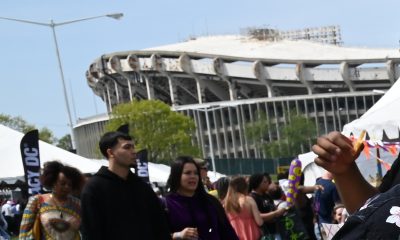Living
Take me out to the ball game
Thousands expected for Gay Softball World Series


Thousands are expected to come to the D.C. area for the Gay Softball World Series. (Photo by Bigstock)
The annual Gay Softball World Series, organized by the North American Gay Amateur Athletic Alliance, is returning to D.C. after 10 years and is expected to be the biggest tournament the organization has ever hosted. The opening ceremonies begin Monday with the tournament to be held Tuesday through Saturday.
“We have over 156 teams confirmed and it will be the largest World Series ever,” says Wayne Williams, co-director of this year’s tournament. “We’ve had tremendous support from the LGBT community and the city itself. The city’s been our partner from the beginning.”
Gay softball teams from all over the U.S. and Canada participate in the Alliance’s Gay Softball World Series each year. The games are free to attend and this year’s expected turnout is between 3,500-4,000 spectators and participants. The Alliance is technically a co-ed organization, but the majority of its teams are all male.
Teams compete in five different divisions, including A, B, C, D and Masters, which is reserved for players 50 and older. Many local Alliance leagues have tournaments to decide which teams will go to the World Series and which division they will compete in.
“The age range varies. You have to be 18 and over to play, and there is no upper age limit,” Williams says. “The Master’s division has been growing each year because a lot of the players are aging.”
Games will be held in a variety of locations outside the city including Watkins Regional Park (301 Watkins Park Dr., Upper Marlboro, Md.), Braddock Park (13241 Braddock Rd., Clinton, Va.), Fairland Regional Park (13950 Old Gunpowder Rd., Laurel, Md.) and Bachman Sports Complex (570 East Ordnance Rd., Glen Burnie, Md.). The exact game times and who will be playing who are still to be announced. The Alliance will not provide buses or vans to the fields for teams or spectators.
“We don’t provide transportation to and from the fields,” Williams says. “We do have an arrangement with the National Car Rental company. They provide discounts for car rentals, so we will connect our players with that service.”
Although the games are free to watch, the Alliance does raise money each year for charity from the teams that pay to compete in the World Series and the week’s social events. The beneficiaries are usually LGBT organizations. This year’s are the You Can Play Project (an LGBT organization that combats discrimination in athletics), Team D.C. and the Team D.C. Student-Athlete Scholarship Fund, the Ben Cohen StandUp Foundation (anti-bullying) and PETS-Washington, D.C. (provides care for pets owned by those living with HIV/AIDS). The Alliance is a registered non-profit with a charitable mission.
“Softball is an opportunity for players to come together as a group and organize activities in that regard, to represent the best of gay softball,” Williams says. “We designate local and national charities for this, so it’s an opportunity to give back.”
The week’s social events include daily afternoon pool parties, Night OUT at the Nationals hosted by Team D.C., an Alliance talent show and a “GrandSlam” after party at Town (2009 8th St., N.W.) on Saturday night. Many of the players and spectators enjoy the sense of community that is a part of each year’s tournament.
“I absolutely love the gay softball community,” says Tony Mase, shortstop for Washington-based team Capital Punishment. “There’s just something about the camaraderie among the teams that play in the league that you don’t get playing in other leagues outside of that community. For instance, our teams play in a straight league on Friday nights, and it’s not that bad to play in it, but it’s just not as fun and outgoing as it is in the LGBT league.”
This year’s World Series will demonstrate the cohesion among D.C.’s gay softball community. Six D.C. teams are competing, which is more than ever before. Ed Vincent, the coach of the Logan Tavern team and co-director for the tournament, describes the World Series as important.
“[The Alliance] provides this opportunity as kind of a safe haven for the LGBT community to play in an organized league setting,” Vincent says. “It’s really important that the players feel comfortable and secure to play in a league where they can compete at all levels, whether it’s the A division that’s the best or the B division that’s more recreational.”
“The tournament really allows the softball players to be role models for LGBT youth and other LGBT people out there. There’s a way to get involved and a way to form an association and a network of friends. It’s almost like a family,” Williams says. “A lot of these people really know each other. It’s a way to help people come out, or feel more comfortable with the coming out process.”
For more information on the 2013 Gay Softball World Series, visit DCseries2013.com.
Events:
MONDAY
Opening Ceremonies are from 6-10 p.m. at Fairgrounds D.C. (1299 Half St., S.E.), and the Opening Ceremonies After-Party is from 9 p.m.-2 a.m. at Ziegfeld’s Secrets (1824 Half St., S.E.). A complimentary shuttle-bus service will loop from Fairgrounds to the after-party at 9, and will drop guests off at the Navy Yard-Ballpark Metro Station until 11.
TUESDAY
The tournament kicks off at 7:50 a.m. at the various fields and the day’s games finish at 5 p.m.
An afternoon pool party for players will be held at Penthouse Pool at VIDA Fitness (1612 U St., N.W.) from noon-6 p.m.
Team D.C. hosts Night OUT at the Nationals at Nationals Park (1500 South Capitol St., S.E.) for tournament contestants. Gates open at 4:30 p.m. with $5 beer in the Night OUT section until first pitch at 7:05 p.m.
WEDNESDAY
Tournament games will be held from 7:50 a.m.-8 p.m. at the various fields, with an afternoon pool party at VIDA Fitness (1612 U St., N.W.) from noon-6 p.m.
Sequioa Restaurant (3000 K St., N.W.) hosts a “Hall of Fame Reception and Dinner” from 7:30-10:30 p.m.
THURSDAY
Tournament games will be held from 7:50 a.m.-6 p.m. at the various fields, with an afternoon pool party from noon-6 p.m. at VIDA Fitness (1612 U St., N.W.).
The Renaissance Hotel Grand Ballroom hosts an Association talent show from 8-11 p.m, with performances by players, coaches and directors. Shi-Queeta-Lee and Bubba D. Licious will be emceeing the event. Admission is $5. For more information and to purchase tickets, visit nagaaatalentshow.eventbrite.com.
FRIDAY
Tournament games will be held from 7:50 a.m.-6 p.m. at the various fields, with an afternoon pool party from noon-6 p.m. at VIDA Fitness (1612 U St., N.W.).
SATURDAY
The NAGAAA Softball Championships will be held from 8 a.m.-4 p.m. at Fairland Regional Park and Watkins Regional Park, with a closing street party and awards ceremony at the Renaissance Hotel’s 8th St. Plaza (999 9th St., N.W.).
Town (2009 8th St., N.W.) hosts the GrandSlam Closing Dance Party from 10 p.m.-3 a.m., with free admission for those with World Series wristbands from 10-11 p.m, and $8 after 11.
Autos
Revving up the holidays with auto-themed gifts
Lamps, mugs, headphones, and more for everyone on your list

Here’s how to shift your holidays into high gear.
Bentley Bottle Stopper

Pop your cork—in a good way—with a Bentley bottle stopper ($106), made of zinc alloy with chrome plating and rubber rings. The classy design is inspired by the automaker’s iconic “Flying B” mascot from 1930.
Subaru Motorsports Counter Stool

Belly up to the bar with the Subaru Motorsports Counter Stool ($175). The 30-inch-tall metal chair—with padded vinyl cover and automaker logo—is lightweight and swivels 360 degrees.
BMW Luxe Luggage

You won’t have trouble spotting this chic khaki-green BMW M Boardcase ($307) at airport baggage carousels. The high-performance “M” logo is etched on the durable polycarbonate casing, as well as on the main compartment zipper and all four of the sturdy double wheels. Comes with recycled lining, along with laundry and shoe bags.
Ford Yoga Gym Bag

The Ford Yoga Gym Bag ($15) has a wide handle and button strap to securely carry a yoga mat, as well as convenient pockets to stow water bottles and shoes. Made of black polyester, with reflective silver Ford logo. (Yoga mat not included.)
Kia Mini Lamp with Speaker/Sound

It doesn’t get much more Zen than a Kia Mini Lamp with Speaker and Sound Machine ($50). Made of bamboo, sturdy plastic and a fabric grill, the tiny wireless lamp has LED lighting with three settings. Pair with your phone to choose from eight soothing sounds: brook noise, bird chirp, forest bird, white bird, ocean wave, rainy day, wind and fireside.
Lexus Green Pro Set

Practice makes perfect with the Lexus Green Pro Set ($257), a putting mat with “train-track markings” to help improve any golfer’s alignment. Lexus logo on the wood frame with automatic ball return.
Lamborghini Wireless Headphones

Turn on, tune in, drop out—well, at least at the end of a hectic day—with these Lamborghini Wireless MW75 Headphones by Master & Dynamic ($901). Batteries last up to 32 hours or up to 28 hours in active noise-canceling mode.
BMW Quatro Slim Travel Tumbler

The BMW Quatro Slim Travel Tumbler ($23) lives up to its name: sleek, smooth and scratch-resistant. Comes with leak-proof lid and non-spill design.
Ford Vintage Mustang Ceramic Mug

Giddy-up each morning with the Ford Vintage Mustang Ceramic Mug ($29). With cool blue stripes, the 14-ounce mug features a silver handle and iconic pony emblem.
My First Lamborghini by Clementoni

Proving it’s never too early to drive an exotic car, My First Lamborghini by Clementoni ($62) is for children ages two- to four-years old. Kids can activate the remote-control car by pressing the button on the roof or by using the remote. This Lambo certainly is less expensive than an entry-level Huracan, which starts at $250,000.
Rolls-Royce Cameo

For adults looking for their own pint-sized luxury ride, there’s the Rolls-Royce Cameo ($5,500). Touted as a piece of art rather than a toy, this miniature collectible is made from the same solid oak and polished aluminum used in a real Rolls. As with those cars, this one even has self-leveling wheel-center caps (which operate independently of the hubcaps so that the RR logo is always in the upright position).
Maserati Notebook

For those of us who still love the art of writing, the Maserati MC20 Sketch Note ($11) is an elegant notebook with 48 sheets of high-quality paper. The front and back covers feature stylish sketches of the interior of a Maserati MC20 supercar and the Maserati logo. Comes with saddle-stitched binding using black thread.
Dodge Demon Dog Collar

If your pooch is more Fluffy-kins and less the guard dog you sometimes need it to be, then there’s the Dodge Demon Seatbelt Buckle Dog Collar ($30). Made of steel and high-density polyester with a tiny seatbelt-buckle clasp, the collar is emblazoned with devilish Dodge Demon logos.
Real Estate
In real estate, it’s déjà vu all over again
1970s and ‘80s volatility led to creative financing options

In the 1970s and 1980s, mortgage interest rates climbed into the double digits and peaked above 18%. With rates like that, you needed more than a steady job and a down payment to buy a home — you needed creative financing ideas.
Today’s market challenges may look different, but the response has been surprisingly familiar: unusual financing methods are making a comeback, along with some new ones that didn’t exist decades ago. Here is a brief overview of the most popular tools from that era.
Assumable Mortgages were available with FHA, VA, and USDA loans and, until 1982, even Conventional mortgages. They allowed a buyer to take over the seller’s existing mortgage, including its interest rate, rather than getting a brand-new loan, while compensating the seller for the difference between the assumed loan balance and the contract price.
Often, a seller played a substantial role in a purchase. With Seller Financing (Owner Carry) the seller became the bank, letting the buyer make payments directly to them instead of to a traditional lender.
One variation on Seller Financing was the Land Contract. The seller was still the lender, but the buyer made loan payments to the seller, who then paid his own mortgage and pocketed the difference. The buyer would receive equitable title (the right to use and occupy the property), while the seller kept the title or deed until the contract was paid off or the property sold.
With Wraparound Mortgages, the seller created a new, larger loan for the buyer that “wrapped” around the existing mortgage at an agreed-upon rate. The buyer would then pay the seller, who would continue making mortgage payments on the existing balance, collecting payments and pocketing the spread. Whether title conveyed to the buyer or remained with the seller was negotiated between the parties.
Unlike an assumption, when buying a home Subject To an existing mortgage, the buyer took title to the property and agreed to pay the seller’s mortgage directly to the lender plus any equity to the seller; the mortgage stayed in the seller’s name. Now, most mortgages have a Due on Sale clause that prohibits this kind of transaction without the expressed consent of the lender.
Rent-to-Own was also a popular way to get into a home. While a potential buyer rented a property, the seller would offer an option to purchase for a set amount to be exercised at a later date (lease option) or allow a portion of the rent collected to be considered as a downpayment once accrued (lease purchase).
Graduated Payment Mortgage (GPM) loans were authorized by the banking industry in the mid-1970s and Adjustable Rate Mortgages (ARM) surfaced in the early 1980s. Both featured low initial payments that gradually increased over time.
With the GPM, although lower than market to start, the interest rate was fixed and payment increases were scheduled. A buyer could rely on the payment amount and save accordingly.
ARMs, on the other hand, had interest rates that could change based on the market index, with less predictability and a higher risk of rate shocks, as we saw during the Great Recession from 2007-2009.
While mortgage rates today aren’t anywhere near the extremes of the 1980s, buyers still face a tough environment: higher prices, limited inventory, and stricter lending standards. That combination has pushed people to explore tried and true alternatives and add new ones.
Assumable mortgages and ARMs are on the table again and seller financing is still worth exploring. Just last week, I overheard a colleague asking about a land contract.
Lenders are beginning to use Alternative Credit Evaluation indicators, like rental payment history or bank cash-flow analysis, to assess borrower strength when making mortgage loan decisions.
There are Shared Equity Programs, where companies or nonprofits contribute part of a down payment in exchange for a share of the home’s future appreciation. With Crowdfunding Platforms, investors pool money online to finance real estate purchases or developments.
Another unconventional idea being debated today is the 50-year mortgage, designed to help buyers manage high home prices. Such a mortgage would have a 50-year repayment term, rather than the standard 30 years, lowering monthly payments by stretching them over a longer period.
Supporters argue that a 50-year mortgage could make monthly payments significantly more affordable for first-time buyers who feel priced out of the market. Critics, however, warn that while the monthly payment may be lower, the lifetime interest cost would be much higher.
What ties the past and present together is necessity. As long as affordability remains strained, creative financing – old and new – will continue to shape the way real estate gets bought and sold. As with everything real estate, my question will always be, “What’s next?”
Valerie M. Blake is a licensed Associate Broker in D.C., Maryland, and Virginia with RLAH @properties. Call or text her at 202-246-8602, email her at [email protected] or follow her on Facebook at TheRealst8ofAffairs.
Real Estate
Could lower rates, lagging condo sales lure buyers to the table?
With pandemic behind us, many are making moves

Before the interest rates shot up around 2022, many buyers were making moves due to a sense of confinement, a sudden need to work from home, desire for space of their own, or just a general desire to shake up their lives. In large metro areas like NYC, DC, Boston, Chicago, Miami and other markets where rents could be above $2k-$3k, people did the math and started thinking, “I could take the $30,000 a year I spend in rent and put that in an investment somewhere.”
Then rates went up, people started staying put and decided to nest in the new home where they had just received a near 3% interest rate. For others, the higher rates and inflation meant that dollars were just stretching less than they used to.
Now – it’s been five years since the onset of the pandemic, people who bought four years ago may be feeling the “itch” to move again, and the rates have started dropping down closer to 5% from almost 7% a few years ago.
This could be a good opportunity for first time buyers to get into the market. Rents have not shown much of a downward trend. There may be some condo sellers who are ready to move up into a larger home, or they may be finding that the job they have had for the last several years has “squeezed all the juice out of the fruit” and want to start over in a new city.
Let’s review how renting a home and buying can be very different experiences:
- The monthly payment stays (mostly) the same. P.I.T.I. – Principal, Interest, Taxes and Insurance – those are the four main components of a home payment. The taxes and insurance can change, but not as much or as frequently as a rent payment. These also may depend on where you buy, and how simple or complex a condo building is.
- Condo fees help pay for the amenities in the building, put money in the building’s reserve funds account (an account used for savings for capital improvement projects, maintenance, and upkeep or additions to amenities)
- Condos have restrictions on rental types and usage – AirBnB and may not be an option, and there could be a wait list to rent. Most condo associations and lenders don’t like to see more than 50% of a building rented out to non-owner occupants. Why? Owners tend to take better care of their own building.
- A homeowner needs to keep a short list of available plumbers, electricians, maintenance people, HVAC service providers, painters, etc.
- Condo owners usually attend their condo association meetings or at least read the notices or minutes to keep abreast of planned maintenance in the building, usage of facilities, and rules and regulations.
Moving from renting to homeownership can be well worth the investment of time and energy. After living in a home for five years, a condo owner might decide to sell, and find that when they close out the contract and turn the keys over to the new owner, they have participated in a “forced savings plan” and frequently receive tens of thousands of dollars for their investment that might have otherwise gone into the hands of a landlord.
In addition, condo sellers may offer buyers incentives to purchase their home, if a condo has been sitting on the market for some time. A seller could offer such items as:
- A pre-paid home warranty on the major appliances or systems of the house for the first year or two – that way if something breaks, it might be covered under the warranty.
- Closing cost incentives – some sellers will help a cash strapped buyer with their closing costs. One fun “trick” realtors suggest can be offering above the sales price of the condo, with a credit BACK to the buyer toward their closing costs. *there are caveats to this plan
- Flexible closing dates – some buyers need to wait until a lease is finished.
- A seller may have already had the home “pre-inspected” and leave a copy of the report for the buyer to see, to give them peace of mind that a 3rd party has already looked at the major appliances and systems in the house.
If the idea of perpetual renting is getting old, ask a Realtor or a lender what they can do to help you get into investing your money today. There are lots of ways to invest, but one popular way to do so is to put it where your rent check would normally go. And like any kind of seedling, that investment will grow over time.
Joseph Hudson is a referral agent with Metro Referrals. He can be reached at 703-587-0597 or [email protected].
-

 District of Columbia4 days ago
District of Columbia4 days agoBowser announces she will not seek fourth term as mayor
-

 U.S. Military/Pentagon4 days ago
U.S. Military/Pentagon4 days agoPentagon moves to break with Boy Scouts over LGBTQ and gender inclusion
-

 Drag5 days ago
Drag5 days agoPattie Gonia calls out Hegseth’s anti-LGBTQ policies — while doing better pull-ups
-

 District of Columbia5 days ago
District of Columbia5 days agoFadi Jaber’s Middle Eastern background shapes Adams Morgan bakery




















